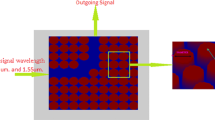Abstract
A microring feedback bend-based coupling resonant system is proposed and is finite difference time domain (FDTD)-simulated to generate electromagnetically-induced transparency (EIT)-like transmission and mode distribution. The coupling between the cross-section of the waveguides gives rise to EIT-like spectrum. Most of the mode field energy is concentrated in the coupling region of the feedback bend. The full-width at half-maximum (FWHM) can be tuned by controlling the gap parameter between two feedback bends. The device enables integration with some photonic devices on a chip and shows great promise in applications such as fast–slow light and optical filters.






Similar content being viewed by others
References
J Kedia and N Gupta, Optik 126, 5641 (2015)
E A J Marcatili, Syst. Tech. J. 48, 2071 (1969)
C Y Chao, S Ashkenazi, S W Huang, M O’Donnell and L J Guo, IEEE Trans. Ultrason. Ferroelectr. Freq. Control. 54, 957 (2007)
V B Braginsky, M L Gorodetsky and V S IIchenko, Phys. Lett. A 137, 393 (1989)
S L McCall, A F J Levi, R E Slusher, S J Pearton and R A Logan, Appl. Phys. Lett. 60, 289 (1992)
L F Stokes, M Chodorow and H J Shaw, Opt. Lett. 7, 288 (1982)
A Yariv, Y Xu, R K Lee and A Scherer, Opt. Lett. 24, 711 (1999)
Q F Xu, J Shakya and M Lipson, Opt. Lett. 14, 6463 (2006)
S E Harris, J E Field and A Imamoglu, Phys. Rev. Lett. 64, 1107 (1990)
D D Smith, H Chang, K A Fuller, A T Rosenberger and R W Boyd, Phys. Rev. A 69, 063804 (2004)
G Y Li, X S Jiang, S Y Hua, Y C Qin and M Xiao, Appl. Phys. Lett. 109, 261106 (2016)
K Totsuka, N Kobayashi and M Tomita, Phys. Rev. Lett. 98, 213904 (2007)
J K S Poon, L Zhu, G A DeRose and A Yariv, Opt. Lett. 31, 456 (2006)
F N Xia, L Sekaric and Y Vlasov, Nat. Photon. 1, 65 (2007)
Y P Xu, L Y Ren, C J Ma, Y L Wang, J Liang and E S Qu, J. Mod. Opt. 61, 1109 (2014)
Y Long, Y Wang, X Hu, M X Ji, L Shen, A D Wang and J Wang, Opt. Lett. 42, 799 (2017)
W T Chen, C J Chen, P C Wu, S L Sun, L Zhou, G -Y Guo, C T Hsiao, K-Y Yang, N I Zheludev and D P Tsai, Opt. Exp. 19, 12837 (2011)
P C Wu, W T Chen, K -Y Yang, C T Hsiao, G Sun, A Q Liu, N I Zheludev and D P Tsai, Nanophotonics 1, 131 (2012)
P C Wu, W L Hsu, W T Chen, Y W Huang, C Y Liao, A Q Liu, N I Zheludev, G Sun and D P Tsai, Sci. Rep. 5, 9726 (2015)
Y J Hsu, B H Cheng, Y Lai and D P Tsai, IEEE J. Quantum Electron. 21, 4600506 (2015)
N H Fouad, A O Zaki, D C Zografopoulos, R Beccherelli and M A Swillama, \(J\). Nanophoton. 11, 016014 (2017)
K S Yee, IEEE Trans. Antenn. Propag. 14, 302 (1966)
Z Zhang, G I Ng, T Hu, H Qiu, X Guo, M S Rouifed, C Liu and H Wang, Opt. Exp. 24, 25665 (2016)
C A Ramos, F Morichetti, A O Moñux, I M Fernández, M J Strain and A Melloni, IEEE Photon. Technol. Lett. 26, 929 (2014)
Z Zhang, G I Ng, T Hu, H Qiu, X Guo, W Wang, M S Rouifed, C Liu and H Wang, Appl. Phys. Lett. 111, 081105 (2017)
A Lovera, B Gallinet, P Nordlander and O J F Martin, ACS Nano 7, 4527 (2013)
D D Smith and H Chang, J. Mod. Opt. 51, 2503 (2004)
C Y Zhao, Pramana – J. Phys. 86, 1343 (2016)
Acknowledgements
This work was supported by the National Natural Science Foundation of China (Grant Number 11504074) and the State Key Laboratory of Quantum Optics and Quantum Optics Devices, Shanxi University, Shanxi, China (Grant Number KF201801).
Author information
Authors and Affiliations
Corresponding author
Rights and permissions
About this article
Cite this article
Zhao, C.Y., Zhang, L. & Zhang, C.M. The FDTD simulation of microring feedback bend-based coupling resonator system for electromagnetically-induced transparency-like effect. Pramana - J Phys 92, 37 (2019). https://doi.org/10.1007/s12043-018-1692-0
Received:
Revised:
Accepted:
Published:
DOI: https://doi.org/10.1007/s12043-018-1692-0
Keywords
- Integrated optics
- microring resonators
- electromagnetically-induced transparency-like effect
- finite difference time domain




